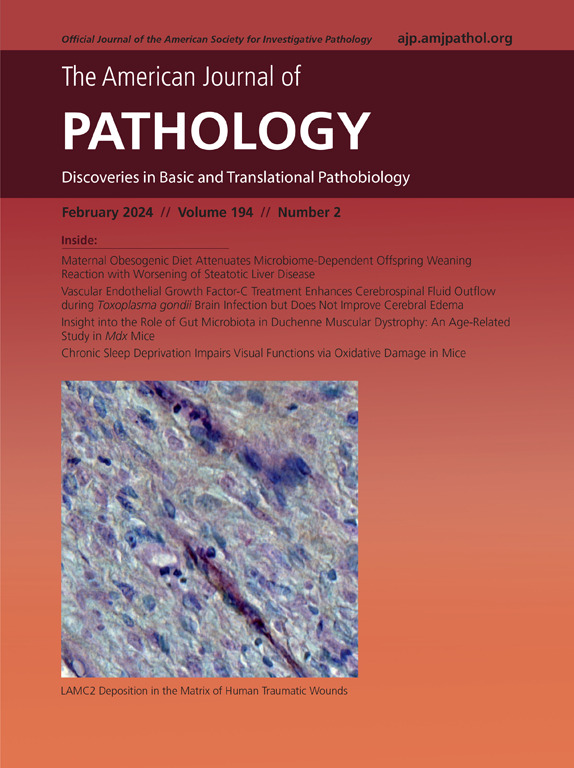C5aR1促进皮肤鳞状细胞癌的侵袭、转移和不良预后
IF 3.6
2区 医学
Q1 PATHOLOGY
引用次数: 0
摘要
皮肤鳞状细胞癌(cSCC)是最常见的转移性皮肤癌,其转移性疾病预后较差。本研究探讨了补体C5a受体C5aR1在cSCC进展和转移中的作用。在成纤维细胞存在的3D球形共培养模型中,C5aR1在cSCC细胞中的表达增加,重组C5a处理增强了cSCC细胞的侵袭性。在体内人cSCC异种移植物侵袭边缘的肿瘤细胞表面检测到C5aR1染色。多重免疫荧光和显色免疫组化对转移性和非转移性原发性人cSCCs、癌前和良性表皮病变以及正常皮肤进行C5aR1染色显示,与原位cSCC、光化性角化病、脂溢性角化病和正常皮肤相比,侵袭性cSCCs和隐性营养不良大泡性表皮松解相关cSCCs的肿瘤细胞和成纤维细胞表面C5aR1表达增加。C5aR1在肿瘤细胞表面和成纤维细胞中的表达增加与原发性cSCC患者的转移风险和较差的疾病特异性生存率相关。这些发现提示C5a在cSCC细胞侵袭中的作用,并确定C5aR1是cSCC患者转移风险和预后不良的新生物标志物。结果还表明,C5aR1可能是治疗局部晚期和转移性cSCC的新靶点。本文章由计算机程序翻译,如有差异,请以英文原文为准。

C5aR1 Promotes Invasion, Metastasis, and Poor Prognosis in Cutaneous Squamous Cell Carcinoma
Cutaneous squamous cell carcinoma (cSCC) is the most common metastatic skin cancer, and the metastatic from is associated with a poor prognosis. Here, the role of the complement C5a receptor C5aR1 was examined in the progression and metastasis of cSCC. C5aR1 expression was increased in cSCC cells in a three-dimensional spheroid coculture model in the presence of fibroblasts, and treatment with recombinant C5a enhanced the invasion of cSCC cells. Staining for C5aR1 was detected on the surface of tumor cells at the invasive edge of human cSCC xenografts in vivo. Metastatic and non-metastatic primary human cSCCs, premalignant and benign epidermal lesions, and normal skin for C5aR1 were stained with multiplex immunofluorescence and chromogenic immunohistochemistry. Increased expression of C5aR1 was observed on the surface of tumor cells and fibroblasts in invasive cSCCs and recessive dystrophic epidermolysis bullosa–associated cSCCs compared with cSCC in situ, actinic keratoses, seborrheic keratoses, and normal skin. Increased expression of C5aR1 on the tumor cell surface and in fibroblasts was associated with metastatic risk and poor disease-specific survival of patients with primary cSCC. These findings suggest a role of C5a in cSCC cell invasion, and they identify C5aR1 as a novel biomarker for metastasis risk and poor prognosis in patients with cSCC. The results also suggest that C5aR1 could be a novel therapeutic target for the treatment of locally advanced and metastatic cSCC.
求助全文
通过发布文献求助,成功后即可免费获取论文全文。
去求助
来源期刊
CiteScore
11.40
自引率
0.00%
发文量
178
审稿时长
30 days
期刊介绍:
The American Journal of Pathology, official journal of the American Society for Investigative Pathology, published by Elsevier, Inc., seeks high-quality original research reports, reviews, and commentaries related to the molecular and cellular basis of disease. The editors will consider basic, translational, and clinical investigations that directly address mechanisms of pathogenesis or provide a foundation for future mechanistic inquiries. Examples of such foundational investigations include data mining, identification of biomarkers, molecular pathology, and discovery research. Foundational studies that incorporate deep learning and artificial intelligence are also welcome. High priority is given to studies of human disease and relevant experimental models using molecular, cellular, and organismal approaches.

 求助内容:
求助内容: 应助结果提醒方式:
应助结果提醒方式:


